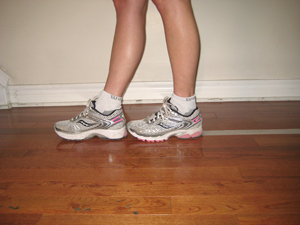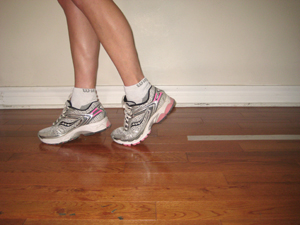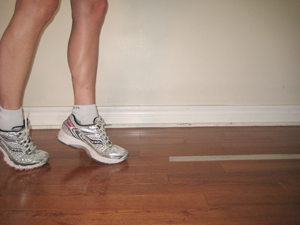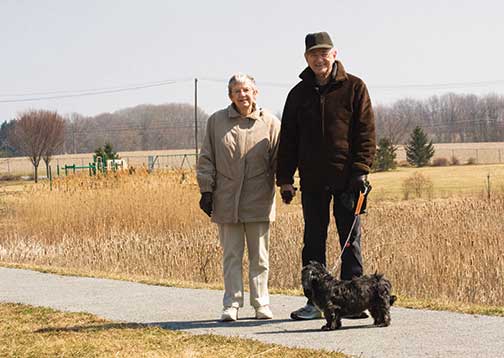Simple exercises to keep Older Adults Moving – Part 2
By John C. Griffin, MSc.
Functional mobility means being able to do the things we need to do in normal daily life efficiently and without undue fatigue or pain. Good functional mobility is part of a healthy, safe, and active life.
This is our second posting on functional mobility. In each posting, we offer you a screening test that helps you identify problems with functional mobility. Then we show you how to use your findings to design exercises for yourself that will improve your functional mobility. (See Simple Exercises — Part 1)
In this test, we will focus on locomotor activities — how you move, how well you can change directions, and what your balance is like while moving. This is important for things like:
- walking on narrow or uneven surfaces
- quick turning or changes in direction
- walking and looking around
Caution: If you have significant pain or increasing pain with any test or exercise, you should stop and get advice from a health care provider.
How to do the Pivot & Walk Test
- Mark out a line 1 metre long on the floor with tape.
- Stand on one end of the line with your back to the line.
- Place one foot in front of the other.
- Line up the heel of one foot touching the toe of the other. You can choose which foot to put in front.
- Keep your arms down at your sides. Keep your head looking forward.
- Lift your heels to stand on your toes.
- In one smooth movement, turn halfway around to face the line, with your feet still in toe/heel position.
- Lower your heels and walk heel to toe along the marked line to the end.

1-5

6

7

8
How did you do?
Score 2 if you were able to do all of these things:
- Turn smoothly.
- Keep your feet on the line after the turn.
- Walk the line staying very straight, with your feet on the line.
- Keep good balance.
Score 1 if you did any of these things:
- You had to pause on the turn.
- You were not on the line after you turned.
- You were not able to keep heel to toe (feet not on the line, or toes pointing off the line)
- You lost your balance a bit.
Score 0 if:
- You could not finish the test because you had too much trouble OR
- You had any pain while doing it.
“Fun Walks”: An exercise to improve your mobility
Now let’s focus on an exercise for the mobility needs that you may have if you scored 0 or 1 in the Pivot & Walk Test. This exercise will improve the strength, stability and balance needed for confident or more difficult walking.
How to do “Fun Walks”
- Place a chair in the middle of the floor.
- Walk around the chair on your toes. (You can touch the chair lightly if you need balance support.)
- Next time around, walk on your heels.
- Now change to the outside of your feet.
- Change again and walk around on the inside of your feet.
- Final time around, be a little creative or combine the various foot positions.
About the Author:
John C. Griffin, MSc., was a professor in the Fitness and Lifestyle Management Program at George Brown College in Toronto for 37 years. As a private consultant, speaker, coach, and writer for public and private sector organizations, John has authored more than 60 publications, numerous manuals, and a textbook published by Human Kinetics, Client-Centered Exercise Prescription. John is currently doing research on the functional mobility of adults 50-70 years of age.
Mobility A “Use it or Lose it” Phenomenon
by Sandra Webber, PhD
Most people don’t need to be convinced of the importance of being able to get around. It’s vital for independence. It means being out there in the community when and where we choose. It means easy connections to friends and family. Mobility is closely linked to both physical and psychological health.
When mobility is impaired by problems such as arthritis or being overweight, activities become restricted. This results in physical deconditioning – loss of strength, balance, and co-ordination.
Mobility limitation has been shown to be an early predictor of physical disability, depression, falls, loss of independence, and institutionalization.
To maintain mobility, it is important to stay active in safe ways. The traditional “use it or lose it” cliché applies. Any form of walking – outdoors, in the hallways, at the mall – is a good idea. Walking builds cardiovascular fitness, muscle endurance, balance, and bone mass. The more we walk, the better we respond to challenges in the environment, such as walking uphill or over uneven ground. That reduces the risk of falls.
Any aerobic activity, such as walking, swimming, dancing, or cycling, helps with weight control and improves the symptoms of arthritis. This kind of exercise strengthens the large muscles in the hips and legs – crucial for things like getting up from a chair and climbing stairs.

For more ideas on keeping fit and mobile, check out Canada’s Physical Activity Guide to Healthy Active Living for Older Adults, available on the Public Health Agency of Canada website.
About the Author
Sandra Webber has a background in physiotherapy and teaches at the University of Saskatchewan. Her research focuses on mobility issues in older adults, the importance of strength and power, and physical activity after knee and hip joint replacements.
A few more tips on healthy aging:
Have your doctor or pharmacist review your medications regularly. This ensures you are getting the best treatment effects and a minimum of side effects.
If you drive, get your vision checked regularly.
Keep your mind active. Do things that challenge cognition, such as reading, playing chess, card games, crossword puzzles, or crafts.
Try to stay “connected.” Maintain a wide social network. Stay abreast of the transportation options in your community. People who do this have more mobility choices available to them.
Click Here for print PDF file – Active Living – Mobility Use it or Lose it Phenomenon

- Categories
Recent Posts

